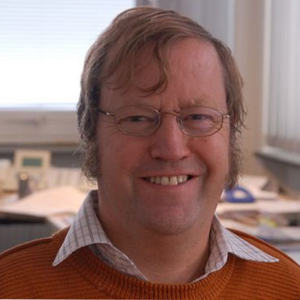
Richard J. Greatbatch has been awarded the 2020 Fridtjof Nansen Medal for his distinguished research in oceanography. At vEGU21 he gave his medal lecture titled ‘From the North Atlantic Oscillation to the Tropics and back’.
Richard, was becoming a scientist your career plan when you were a mathematician student?
Yes, I always wanted to be a scientist and, in particular, to work on something to do with the dynamics of the atmosphere and the ocean. I think I took my inspiration from the severe European winter of 1962/63 when I had 6 weeks off school because of the failure of the heating system. This was very unusual in the northwest of England where I grew up!
Tell us about your academic journey and how you got here? Any mentors, major hurdles in the way, inspirations that helped you to prevail?
I did my Bachelor degree at the University of Liverpool in Mathematics with a minor in Physics. One of the professors there at the time, Dr. Philip Chatwin, encouraged me to go to Cambridge for my Ph.D. which I did. To be accepted for a Ph.D. in the Department of Applied Mathematics and Theoretical Physics at Cambridge it was necessary to first take Part III of the Mathematical Tripos, and acceptance was conditional on doing well in the exams at the end of Part III. I was fortunate to work with Dr. Adrian Gill at Cambridge. At that time my mentors were Philip Chatwin and Adrian Gill. Sadly, Adrian died in 1986 and for a while after that time I looked for support to colleagues at the Geophysical Fluid Dynamics Laboratory in Princeton, USA, where I had been a postdoctoral researcher, particularly Drs. Kirk Bryan, George Mellor and George Philander. It was also at this time that I moved to Canada and took up a tenure track faculty position at Memorial University of Newfoundland where I stayed for 12 years, rising through the ranks to Full Professor.
Then, in 1998, I took up a professorship as an NSERC Industrial Research Chair in the Department of Oceanography at Dalhousie University in Nova Scotia. I stayed at Dalhousie University for 9 years before becoming the Professor for Theoretical Oceanography in Kiel, Germany, at what is nowadays the GEOMAR Helmholtz Centre for Ocean Research Kiel. The institute in Kiel has a long history, being formerly known as the Institut für Meereskunde. One of its early directors was Georg Wüst who had been one of the leaders of the pioneering research cruises in the Atlantic on the Meteor in the 1920’s. These observations clearly revealed the Atlantic Meridional Overturning Circulation (AMOC) that we know is important for climate and is the subject of so much research since that time up to today. Our descriptive picture of that circulation is, nevertheless, nicely captured by those first results from the Meteor.

Block diagram of the Atlantic circulation between 0 and 6000 m. (Wüst, G. 1950)
Looking back at your research career, what do you think your major breakthroughs are and why?
The achievement I am most proud of came about quite recently and would not have been possible without my colleagues at GEOMAR, especially Drs. Peter Brandt and Martin Claus. The idea came to me when I was hiking with my brother in the Lake District in England. I started thinking that the maintenance of the equatorial deep jets, which has been a subject of research for many years by a number of different groups, is analogous to the maintenance of the jet stream in the atmosphere. It is an example of why I think working on both the ocean and the atmosphere at the same time is a good thing to do because of the insights it brings to our understanding of both systems and of the climate system as a whole.
Not only were we able to verify the mechanism in an ocean model set-up that supports deep jets but we were really fortunate to have two moorings either side of the equator in the Atlantic at 23 W that enabled us to show that the proposed mechanism also works in the real world. This is a very good example of how theory, modelling and observations combined can make for really successful and satisfying research.

Schematic depiction of the model experiment design for equatorial deep jets. (Bastin et al. 2020)
From the past, I would point to my paper with my friend and colleague Dr. Kevin Lamb who is now at the University of Waterloo in Canada (Greatbatch & Lamb 1990). We proposed that the effect of mesoscale eddies in the ocean could be parameterized using a vertical mixing of momentum term in the momentum equations carried by models. At the time, we did not know about the work being simultaneously carried out by Drs. Peter Gent and Jim McWilliams at the National Centre for Atmospheric Research in the USA (Gent & McWilliams 1990). In fact the Gent and McWilliams and Greatbatch and Lamb approaches are entirely complementary. If I have a regret today it is that we did not push the Greatbatch and Lamb approach hard enough with the result that the Gent and McWilliams parameterization is the one that is commonly used today. But I know that Greatbatch and Lamb has many fans, nonetheless.
As a final example, I am really pleased that I was able to write a paper on the winter of 1962/63, the starting point for my career! This paper was written together with Dr. Gereon Gollan, who at that time was my Ph.D. student (Greatbatch et al. 2015). We showed the important role played by the tropics in driving the unusual and persistent atmospheric circulation anomalies during that particular winter.

Mean 2 m temperature anomaly over December, January and February (DJF) with respect to the reference period 1960/1961–2001/2002 (all data from the ERA-40 reanalysis). Red (blue) contours indicate warm (cold) anomalies. The contour interval is 1°C and the zero contour is omitted. (Greatbatch et al. 2015)
What is your research vision, the fundamental question that you are interested to address as a scientist?
I would like to see an improvement in our skill at making seasonal and decadal predictions. Successful decadal prediction is becoming more and more urgent because of climate change – one thinks of Arctic sea-ice loss, for example, or projections for the ocean uptake of CO2, or global mean surface air temperature. The Pacific sector is particularly important in this regard because of the atmospheric teleconnections, even as far as Europe, that are driven from that sector – think of El Nino Southern Oscillation (ENSO), for example, and the impact ENSO has throughout the world. I have been involved in research in recent years showing that even when using a relatively simple initialization scheme using surface wind stress, progress can be made predicting future conditions in the equatorial Pacific. Projecting what will happen in the equatorial Pacific sector is also, in my opinion, essential for understanding regional climate change associated with global warming. But the models require improvement and we need better initialization techniques and better ways to represent unresolved processes. This has been a theme of my research throughout my career. The recent progress at the UK Met Office in the group led by Dr. Adam Scaife, especially with seasonal prediction, is really encouraging in this respect.
What would you identify as the main gaps or big picture questions of ocean and climate dynamics for the coming decades that you think early career scientists can pursue?
As I mentioned above, I think improving our predictive skill in the Pacific sector, especially the equatorial Pacific, is particularly important. However, to improve the models we use for prediction, developing new and novel approaches to parameterize unresolved processes is of the uttermost importance. A good example would be the energy backscatter technique recently developed by Dr. Malte Jansen at Princeton and then extended by Milan Klöwer (now a Ph.D. student at Oxford) for his Master’s thesis working with Malte Jansen, myself and Drs. Martin Claus and Sören Thomsen. This technique is showing real promise for improving large scale ocean models and yet it is also rooted in very simple and basic dynamical principles.
What major challenges are you most interested to tackle as a numerical modeler?
Undoubtedly model improvement, of which the backscatter technique I refer to above is an example, and the related issue of reducing model bias. It is really shocking how strong some of the model biases are, for example the very common North Atlantic cold bias or the southeast tropical Atlantic warm bias, both of which are common model problems. I have been involved in research on both these issues in recent years but much work remains to be done.
What were your feelings when you received the news that you received the Fridtjof Nansen medal 2020?
I felt very honoured!
Thank you so much Richard, for the interview and for your career advice!
Interviewed and edited by Meriel J. Bittner & Gwyn Evans
References & Further reading:
- Bastin S, Claus M, Brandt P, Greatbatch RJ (2020) Equatorial Deep Jets and Their Influence on the Mean Equatorial Circulation in an Idealized Ocean Model Forced by Intraseasonal Momentum Flux Convergence. Geophys Res Lett 47.
- Greatbatch RJ, Lamb KG (1990) On Parameterizing Vertical Mixing of Momentum in Non-eddy Resolving Ocean Models. J Phys Oceanogr 20:1634–1637.
- Gent, P. R., & Mcwilliams, J. C. (1990) Isopycnal mixing in ocean circulation models. Journal of Physical Oceanography, 20(1):150-155.
- Wüst, G. (1950) Blockdiagramme der Atlantischen Zirkulation auf Grund der “Meteor”-Ergebnisse. Kieler Meeresforschung, 7, no. 1, pp. 24-34.
- Gent, P. R. (2011) The Gent–McWilliams parameterization: 20/20 hindsight. Ocean Modelling, 39(1-2), 2-9.
- Greatbatch, R. J., Gollan, G., Jung, T., & Kunz, T. (2015) Tropical origin of the severe European winter of 1962/1963. Quarterly Journal of the Royal Meteorological Society, 141(686), 153-165.
- Jansen, M. F., & Held, I. M. (2014) Parameterizing subgrid-scale eddy effects using energetically consistent backscatter. Ocean Modelling, 80, 36-48.
- Klöwer, M., Jansen, M. F., Claus, M., Greatbatch, R. J., & Thomsen, S. (2018) Energy budget-based backscatter in a shallow water model of a double gyre basin. Ocean Modelling, 132, 1-11.


Pingback: Ocean Sciences | Call for nominations for the EGU medals & awards 2022